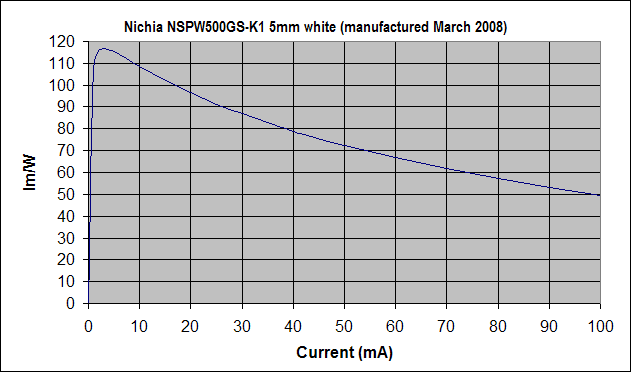One thing that plays into runtime, and I only bring this up as information (just thought of it), is how low of a voltage can each driver work down to? On paper an 85% efficient driver that only works down to 1.1V is not going to drive an led as long as an 85% driver that works down to 0.8V.
Has anyone plotted battery voltage along with light output for both the Arc and the E01? What's the forward voltage of the GS LED?
Well, the E01 has ultra flat regulation, i.e. the light output doesn't vary with the battery voltage. What that means in terms of efficiency as the battery runs down, I don't know. There were some tests and graphs of the Arc converter in the electronics forum a long while back. The runtime curve is also well known and can probably be mapped to battery voltage using the various discharge curves for AAA cells (or maybe extrapolating from AA cells) in the battery testing threads.
The Arc does not really try to maximize the total number of photons per battery. As I understand it, Peter through various considerations decided that an EDC light of this type should have 5 hours of runtime. He then made the light as bright as he could within the constraint of having a generic alkaline battery last that long before its sharp drop-off, with some safety margin and taking into account that batteries have varying capacity (so with good batteries you get more like 6-8 hours). That is the reason for semi-regulation as I understand it: he wanted a good output level at 5 hours, but if more power than that was available earlier in the run, he wanted to use it and get more lumens during that part of the run, not save it for more runtime beyond 5 hours.
It looks like 5mm leds are most efficient at around 5-10 mA so perhaps the ultimate in efficiency would be to use three of them like in the Peak Matterhorn 3-led version.
I personally prefer the Arc's semi-regulated scheme since I don't use the light in long enough stretches for runtime to be an issue. Batteries last me for many months. I notice the light getting dimmer when it's maybe halfway down the curve, which means there's still an hour or two left before moon mode, and I know to get around to changing the battery. With flat regulation, I have no such advance warning, it's at a constant level til boom, the light becomes very feeble in an instant.
Ray mentions that the E01 was able to light up at 0.45V, which is pretty interesting--does that mean at a super low glow, or ...?
With the Arc, you can run an AAA cell to near-extinction, then turn off the light and rest the cell for a few minutes, then turn it back on and get a good lighting level for quite a long time (1/2 hour or more), and you can repeat this several times. I'll do a similar test with my E01 when it arrives.




